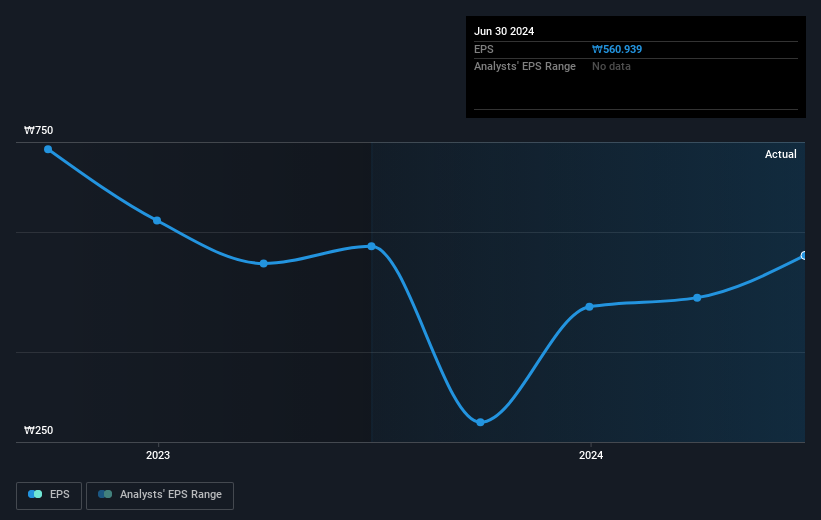- South Korea
- /
- Semiconductors
- /
- KOSDAQ:A144960
The three-year shareholder returns and company earnings persist lower as New Power Plasma (KOSDAQ:144960) stock falls a further 12% in past week

In order to justify the effort of selecting individual stocks, it's worth striving to beat the returns from a market index fund. But the risk of stock picking is that you will likely buy under-performing companies. We regret to report that long term New Power Plasma (KOSDAQ:144960) shareholders have had that experience, with the share price dropping 32% in three years, versus a market decline of about 16%. The falls have accelerated recently, with the share price down 17% in the last three months. Of course, this share price action may well have been influenced by the 9.8% decline in the broader market, throughout the period.
If the past week is anything to go by, investor sentiment for New Power Plasma isn't positive, so let's see if there's a mismatch between fundamentals and the share price.
Check out our latest analysis for New Power Plasma
In his essay The Superinvestors of Graham-and-Doddsville Warren Buffett described how share prices do not always rationally reflect the value of a business. One imperfect but simple way to consider how the market perception of a company has shifted is to compare the change in the earnings per share (EPS) with the share price movement.
New Power Plasma saw its EPS decline at a compound rate of 22% per year, over the last three years. In comparison the 12% compound annual share price decline isn't as bad as the EPS drop-off. This suggests that the market retains some optimism around long term earnings stability, despite past EPS declines.
The graphic below depicts how EPS has changed over time (unveil the exact values by clicking on the image).

Before buying or selling a stock, we always recommend a close examination of historic growth trends, available here.
What About Dividends?
As well as measuring the share price return, investors should also consider the total shareholder return (TSR). The TSR incorporates the value of any spin-offs or discounted capital raisings, along with any dividends, based on the assumption that the dividends are reinvested. So for companies that pay a generous dividend, the TSR is often a lot higher than the share price return. We note that for New Power Plasma the TSR over the last 3 years was -30%, which is better than the share price return mentioned above. This is largely a result of its dividend payments!
A Different Perspective
We regret to report that New Power Plasma shareholders are down 13% for the year (even including dividends). Unfortunately, that's worse than the broader market decline of 3.4%. However, it could simply be that the share price has been impacted by broader market jitters. It might be worth keeping an eye on the fundamentals, in case there's a good opportunity. Longer term investors wouldn't be so upset, since they would have made 4%, each year, over five years. It could be that the recent sell-off is an opportunity, so it may be worth checking the fundamental data for signs of a long term growth trend. While it is well worth considering the different impacts that market conditions can have on the share price, there are other factors that are even more important. Take risks, for example - New Power Plasma has 1 warning sign we think you should be aware of.
If you like to buy stocks alongside management, then you might just love this free list of companies. (Hint: many of them are unnoticed AND have attractive valuation).
Please note, the market returns quoted in this article reflect the market weighted average returns of stocks that currently trade on South Korean exchanges.
Valuation is complex, but we're here to simplify it.
Discover if New Power Plasma might be undervalued or overvalued with our detailed analysis, featuring fair value estimates, potential risks, dividends, insider trades, and its financial condition.
Access Free AnalysisHave feedback on this article? Concerned about the content? Get in touch with us directly. Alternatively, email editorial-team (at) simplywallst.com.
This article by Simply Wall St is general in nature. We provide commentary based on historical data and analyst forecasts only using an unbiased methodology and our articles are not intended to be financial advice. It does not constitute a recommendation to buy or sell any stock, and does not take account of your objectives, or your financial situation. We aim to bring you long-term focused analysis driven by fundamental data. Note that our analysis may not factor in the latest price-sensitive company announcements or qualitative material. Simply Wall St has no position in any stocks mentioned.
About KOSDAQ:A144960
New Power Plasma
New Power Plasma Co.,Ltd engages in development and sale of plasma components for wafer and LCD processing in the semiconductor/LDC/OLED industry in South Korea and internationally.
Slightly overvalued with questionable track record.


